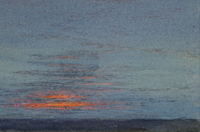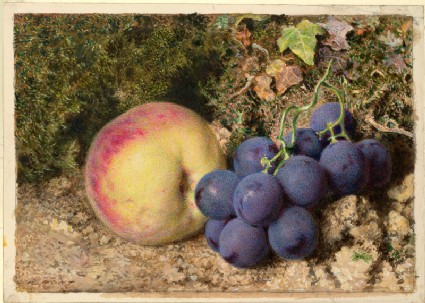Ruskin's Educational series, 1st ed. (1871)
Ruskin's first catalogue of 300 works for the instruction of undergraduates and his notes on the use of particular examples.

Ruskin's Catalogues: 1 object
Show search help- Reference URL
Actions
Peach and Grapes William Henry Hunt
-
Ruskin text
212, 213.Pieces of still life, which, with 199 and 200, are enough to show you the management of colour with surrounding shadow, as opposed to flat tinting; but note further in the Hunt its general look of greengrocery, and character of rustic simplicity, as opposed to the grave refinement of the Italian designers. Generally speaking, you will find our best modern art has something of this quality,—it looks as if done by peasants or untrained persons, while good Italian work is visibly by accomplished gentlemen. The reason of this, of course, primarily is, that our artists do not think their general education of importance, nor understand that it is an essential part of their eventual art-power; but it results, also, much from an Englishman’s delight in taking his own way, and his carelessness and general ignorance of vital abstract principle, so only that he gets a momentarily pleasant effect; which carelessness he thinks a practical turn of mind in him. I like to see a thing fudged out, said William Hunt once to me. Yes, but to see it felt out, and known, both out and in, is better still.
Nevertheless, the simplicity has its own charm, when it is modest also; as in Hunt and Bewick: unhappily there is a tendency in the modern British mind to be at once simple and insolent: a most unfortunate base metal.
Secondly, note of the method of work of this picture. It assumes that you are looking at the fruit very near it; and at that only. And the mode of finish is on those conditions admirable; but only on the condition, observe, that this piece of painting is to be no part of a larger scene. If these grapes were in the hand of a figure, and, to see the figure, you had to retire six or seven feet, all the laborious and careful completion of bloom would be useless and wrong.
Lastly, note in the Hunt, that though the peach is yellow, and the grapes blue, it is as easy to throw the blue fruit before the golden one, as it would have been to throw a cluster of golden grapes before a blue plum. And be advised, once for all, that there are no such things as retiring or advancing colours; but that every colour, well taught, is equally ready to retire when you wish it to retire, and to advance when you wish it to advance; and that you must by your own magic, and by that alone, command the delicate amber into the infinite of twilight, or complete it into the close bloom of the primrose in your hand.
-
Details
- Artist/maker
-
William Henry Hunt (1790 - 1864)
- Object type
- drawing
- Material and technique
- watercolour and bodycolour over graphite on paper
- Dimensions
- 124 x 175 mm
- Inscription
- Recto, bottom left, in watercolour: W HUNT
- Provenance
-
Presented by John Ruskin to the Ruskin Drawing School (University of Oxford), 1875; transferred from the Ruskin Drawing School to the Ashmolean Museum, c.1949.
- No. of items
- 1
- Accession no.
- WA.RS.ED.213
-
Subject terms allocated by curators:
Subjects
-
References in which this object is cited include:
References
Ruskin, John, Catalogue of the Educational Series (London: Smith, Elder, 1871), cat. Educational no. IX.1.L
Ruskin, John, Catalogue of the Educational Series (London: Spottiswoode, 1874), cat. Educational no. 213
Ruskin, John, Catalogue of Examples Arranged for Elementary Study in the University Galleries (Oxford: Clarendon Press, 1870), cat. Educational no. 43
Witt, John, William Henry Hunt (1790-1864): Life and Work, with a Catalogue (London: Barrie and Jenkins, 1982), no. 689, colour pl. 22
Ruskin, John, ‘The Ruskin Art Collection at Oxford: Catalogues, Notes and Instructions’, Edward T. Cook and Alexander Wedderburn, eds, The Works of John Ruskin: Library Edition, 39 (London: George Allen, 1903-1912), 21, cat. Educational no. 213
Location
-
- Western Art Print Room
Position in Ruskin’s Collection
Ruskin's Catalogues
-
Ruskin's Catalogue of Examples (1870)
Grapes and peach. (William Hunt.)It is not a first-rate Hunt; you shall have a better, some day, among the Standards: this, however, illustrates several matters of importance, and is placed here for present comparison, and eventual service.
First, I want you to notice its general look of greengrocery, and character of rustic simplicity, as opposed to the grave refinement of Mantegna. Generally speaking, you will find our best modern art has something of this quality,—it looks as if done by peasants or untrained persons, while good Italian work is visibly by accomplished gentlemen. The reason of this, of course, primarily is, that our artists do not think their general education of importance, nor understand that it is an essential part of their eventual art-power; but it results also much from an Englishman’s delight in taking his own way, and his carelessness and general ignorance of vital abstract principle, so only that he gets a momentarily pleasant effect; which carelessness he thinks a practical turn of mind in him. I like to see a thing fudged out, said William Hunt once to me. Yes, but to see it felt out, and known, both out and in, is better still.
Nevertheless, the simplicity has its own charm, when it is modest also; as in Hunt and Bewick: unhappily there is a tendency in the modern British mind to be at once simple and insolent; a most unfortunate base-metal.
Secondly, note of the method of work of this picture. It assumes that you are looking at the fruit very near it; and at that only. And the mode of finish is on those conditions admirable; but only on the condition, observe, that this piece of painting is to be no part of a larger scene. If these grapes were in the hand of a figure, and, to see the figure, you had to retire six or seven feet, all this laborious and careful completion of bloom would be useless, and wrong. Here, 43 B, are bunches of black and white grapes, from Rubens’ Peace and War, in the National Gallery. Mr. Ward has fairly enough for my present purpose (he shall do it afterwards better), facsimiled the few touches, by which, in about ten minutes of the master’s work, these masses of fruit have been set nobly in their place. The two examples will show you clearly the difference between genre painting and that of the great schools; only remember, that Rubens always errs by inattention and violence, and if the higher example had been by Titian, it would have seemed as complete as Hunt’s , though majestic also.
Lastly, note in the Hunt, that though the peach is yellow, and the grapes blue, it is as easy to throw the blue fruit before the golden one, as it would have been to throw a cluster of golden grapes before a blue plum. And be advised, once for all, that there are no such things as retiring or advancing colours; but that every colour, well taught, is equally ready to retire when you wish it to retire, and to advance when you wish it to advance; and that you must by your own magic, and by that alone, command the delicate amber into the infinite of twilight, or complete it into the close bloom of the primrose in your hand.





